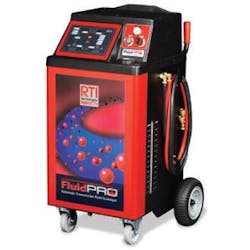When it comes to selling fluid service/exchange machines, you have a few advantages from other capital equipment. One major plus is that the units typically have a smaller footprint in your truck (usually less than a tool cart) than other shop equipment. For the forward-thinking distributor, selling fluid exchange equipment into a shop is an opportunity for future consumables sales in the form of fluid diagnostic strips and the like.
So, now that you’re intrigued about moving some fluid service machines, what do you need to know about the questions your shop owners will be (or should be) asking in their evaluation process?
FEATURES
The three most important categories customers should consider are equipment functionality, equipment reliability/durability and technician interface, according to Kelvin Butz, of RTI Technologies. The specifics will vary between different price points and the type of service, but each has impact on any machine.
For functionality, Butz said buyers should key on first-pass exchange percentage, cycle time, ease of connection and equipment portability.
“It is a huge advantage to have a unit that is portable,” said Geoff Preston, of Motorvac. “This way multiple services can be performed without moving a car. As soon as the machine is finished with a service unhook it, wheel it over to the next car, start it again. Maneuverability also helps when servicing a car that cannot be moved.”
Preston added that a machine with a small footprint will be valuable to keep the shop from feeling cluttered and make it easy to “navigate through tight walkways and between cars.”
As to reliability and durability, Butz said shops will consider robust design/construction, quality of components and brand reputation.
“A unit should have a stellar reputation backed with a good warranty. It should also use quality parts and pumps,” Preston agreed.
Ease of use are important for the techs who will operate the equipment, Butz said. A buyer will be considering whether a product has “easy connection/disconnection, is easy to fill with new fluids, is easy to dispose of used fluids and if it is spill-proof.”
There are fluid exchange machines available for all fluid services, from transmissions and coolant to oil and brakes, and each will have different features depending on brand and price point.
ONE-FOR-ALL MACHINES
Preston and Butz both agree that offering all-in-one machines is more likely to be bad for customers.
“RTI … decided against developing and manufacturing this type of machine due to machine internal fluid contamination issues when switching to non-compatible fluids,” said Butz. “Also, this plays havoc with recycling used fluids.”
“These units are confusing to some technicians and are often contaminated with other fluids as a result of human error,” Preston said. “This could lead to potential problems if incorrect fluids contaminate certain vehicle systems.”
Take a look at some of these fluid exchange machines from RTI and Motorvac now that you’re thinking about it:
ATX-3
Automatic Transmission Fluid Exchanger with Dipstick Tube Exchange
The first transmission fluid machine to offer fully automatic operation using an accurate exchange process as well as offer the dipstick tube exchange service option.
Motorvac launched the CoolantClean III MCF 5100, the third generation of their original machine. The system is designed to exchange virtually all used coolant in a few simple steps, and to perform both static and dynamic operations. The machine features an onboard 28-quart waste tank and a removable stainless steel mesh screen filter for easier service, as well as dual pump action for a faster, more efficient service time.
The BFX-2 Brake Flush System by RTI connects to vehicles and completes the fluid exchange in five to ten minutes. Features include:
• Universal master cylinder adapters with vehicle reference quick guide.
• Adapts to many types of brake fluid bottles.
• Automatic shut-off and illuminated warning lights when new fluid tank is empty or used tank is full.
• Pistol wand allows for accurate filling of master cylinder.


